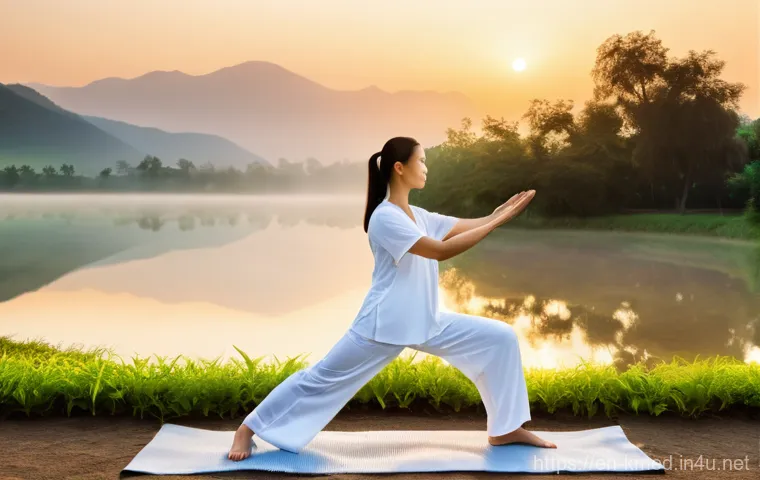Hey there, wellness seekers! In our fast-paced world, it’s easy to feel disconnected from our bodies, always chasing a quick fix. But what if ancient wisdom held the key to a more harmonious, balanced you?
I’ve personally found immense value in exploring the foundational principles of Traditional Korean Medicine, particularly the fascinating concept of acupressure points.
Understanding how to tap into your body’s natural energy pathways can be incredibly empowering, offering a gentle yet profound path to better health. Let’s delve into these incredible insights and unlock a new perspective on well-being together.
Unlocking Your Inner Healer: The Meridian Map

Tracing the Energy Pathways
I remember feeling totally lost when I first heard about “meridians.” It sounded a bit mystical, honestly, like something out of a fantasy novel. But as I delved deeper into Traditional Korean Medicine, I started to see these pathways not as invisible magic, but as an incredibly logical and intricate map of how our body’s energy, or *Qi*, flows.
Think of them as superhighways for life force, connecting everything from your organs to your emotions and even your skin. When I personally started tracing these imaginary lines on my own body, visualizing the energy moving, it shifted my perspective entirely.
It’s not just theoretical; understanding where these pathways run actually helps you make sense of why a pain in your shoulder might be related to your liver, or why a point on your hand can ease a headache.
It’s truly empowering to realize your body isn’t a collection of separate parts, but a beautifully interconnected system, and you have a roadmap to navigate it.
I’ve found that this understanding alone can bring a sense of calm, knowing there’s an underlying order to our physical experiences. It’s like discovering your body comes with its own sophisticated internal GPS!
My own journey with these concepts has opened my eyes to how intricate and responsive our bodies truly are, and how much innate healing power we possess.
The Flow of Life Force (Qi)
Now, let’s talk about *Qi* – pronounced “chee.” This isn’t just some abstract concept; it’s the very vitality that animates us. Imagine a river. When the river flows freely, everything around it thrives.
But if there’s a dam or a blockage, the water stagnates, and problems start to emerge downstream. That’s exactly how *Qi* works in our bodies. When your *Qi* is flowing smoothly and abundantly, you feel vibrant, energetic, and balanced.
I’ve definitely experienced times when my *Qi* felt blocked – those days when I was inexplicably sluggish, irritable, and just felt ‘off,’ even if nothing was physically wrong.
Traditional Korean Medicine teaches us that these blockages can lead to all sorts of discomfort, from minor aches to deeper imbalances. The beauty of practices like acupressure is that they help gently nudge that *Qi* back into motion, clearing the way for health and harmony.
It’s not about forcing anything; it’s about supporting your body’s natural tendency to heal and find equilibrium. I’ve personally felt a profound sense of relief and renewed energy after even a short session of focusing on my *Qi* flow, and it’s a feeling that genuinely makes you appreciate the wisdom of these ancient practices.
It’s a subtle yet powerful shift that reminds you of your body’s incredible capacity for self-regulation and resilience.
Gentle Pressure, Profound Relief: Acupressure in Action
More Than Just a Massage
When I first tried acupressure, I admit, I thought it might just be a fancy word for a deep tissue massage. Boy, was I wrong! While there’s certainly a soothing, tactile element, acupressure is so much more targeted and intentional.
Instead of broadly working muscles, we’re focusing on specific points along those meridian pathways we just talked about. Each point isn’t just a random spot; it’s like a tiny switch connected to a much larger circuit board, designed to influence particular organs, functions, or emotional states.
I’ve noticed a huge difference in how quickly and effectively a targeted acupressure session can alleviate discomfort compared to a general rubdown. It’s truly about understanding the body’s energetic language and applying just the right amount of gentle pressure to encourage healing and balance.
It’s not about brute force; it’s about respectful engagement with your body’s intricate systems. The beauty lies in its simplicity and profound efficacy.
Empowering Self-Care Techniques
One of the most incredible aspects of acupressure, for me, is how incredibly empowering it is as a self-care tool. You don’t always need a practitioner; you can learn basic techniques to address common issues right in your own home or even at your desk.
I remember a particularly stressful week when I felt tension building in my neck and shoulders, and a nagging headache started to creep in. Instead of reaching for painkillers immediately, I tried a few simple acupressure points I’d learned.
Within minutes, I felt the tension begin to melt away, and the headache subsided significantly. It was a revelation! This isn’t about replacing professional medical advice, but it’s about having a gentle, accessible, and drug-free option in your wellness toolkit.
It gives you a sense of agency over your own well-being, proving that you have incredible resources within your own body to tap into. It’s a wonderful feeling to know you can offer yourself some comfort and relief whenever you need it most.
Beyond the Clinic: Everyday Acupressure for Modern Woes
Combatting Digital Strain
Let’s be real, in our modern lives, we’re constantly glued to screens. This digital reliance, while convenient, has ushered in a whole new set of physical complaints: tech neck, eye strain, and that pervasive tension across the upper back.
I used to think these were just unavoidable consequences of my job, but discovering targeted acupressure has been a game-changer. For example, massaging the points at the base of your skull or between your thumb and index finger can provide surprising relief for headaches and neck stiffness linked to screen time.
It’s truly amazing how a few minutes of mindful pressure can counteract hours of hunching over a laptop or phone. I’ve made it a habit to take short acupressure breaks throughout my workday, and I’ve noticed a significant reduction in the chronic discomfort I used to experience.
It’s a proactive step that makes a real difference in how I feel at the end of the day, helping me reclaim comfort from the digital grind.
De-stressing Your Day, One Point at a Time
Life throws a lot at us, and managing stress has become a daily art form. While meditation and exercise are fantastic, sometimes you need a quick, discreet way to calm your nervous system, especially when you’re in the thick of it.
That’s where acupressure truly shines for me. I’ve found that gently pressing the “Spirit Gate” point on my wrist, or the point between my eyebrows, can instantly bring a sense of tranquility when I feel overwhelmed.
It’s not just a distraction; it’s like sending a direct signal to my body to dial down the fight-or-flight response. I’ve used these techniques before big meetings, during travel delays, or just when I need a moment of peace amidst a hectic schedule.
It’s incredibly accessible, requires no special equipment, and can be done anywhere, anytime. Incorporating these small, intentional moments of self-care has fundamentally changed how I navigate daily stressors, turning what used to be overwhelming moments into opportunities for mindful self-soothing.
Finding Your Balance: TKM Principles for Daily Living
Harmony of Yin and Yang
The concepts of Yin and Yang might sound complex, but at their heart, they’re incredibly intuitive and profoundly practical for daily living. Essentially, they describe the complementary, interconnected forces that exist in everything – light and dark, hot and cold, activity and rest.
In Traditional Korean Medicine, maintaining a balance between these forces within our bodies is key to health. I used to push myself constantly, always on the go, always striving, embodying pure Yang energy.
But I learned the hard way that neglecting my Yin – rest, nourishment, introspection – led to burnout and feeling completely out of sync. Now, I consciously seek to balance my high-energy workdays with quiet evenings, invigorating exercise with restorative sleep, and warm, cooked meals with lighter, cooling options.
It’s about creating a dynamic equilibrium, not a static one. Embracing this philosophy has helped me listen more deeply to my body’s needs and create a lifestyle that genuinely supports my overall well-being, preventing the extreme swings that once left me feeling depleted.
The Five Elements and Your Health
Another fascinating layer of Traditional Korean Medicine is the Five Elements theory: Wood, Fire, Earth, Metal, and Water. Each element is associated with specific organs, emotions, seasons, and even tastes.
Understanding this framework has been like unlocking a secret code for my own health and personality. For instance, I’ve always been prone to a bit of ‘Wood’ energy imbalance – think irritability and tension – especially in spring.
Knowing this helps me choose foods, activities, and even colors that nourish my ‘Wood’ element and keep my liver energy flowing smoothly. It’s not about rigid adherence, but about gaining insights into your unique constitution and tendencies.
For someone who might feel constantly anxious, they might explore how their ‘Water’ element (associated with the kidneys and fear) is functioning. This holistic view means that a physical symptom isn’t isolated; it’s a message from a larger system.
It encourages a more compassionate and informed approach to self-care, allowing me to tailor my wellness practices in a truly personalized way.
Your Body’s Pharmacy: Key Acupressure Points to Know

Quick Relief Points for Common Ailments
It’s truly incredible how your body holds its own internal pharmacy, with specific points that can offer relief for a surprising array of common discomforts.
I’ve personally experimented with many of these points, and the immediate, gentle relief they provide is something I swear by. It’s empowering to know that a nagging headache, an upset stomach, or even a sudden bout of anxiety doesn’t always require reaching for a pill.
Sometimes, your own fingertips are the best remedy. I remember one particular instance when I had a terrible tension headache after hours of staring at my computer screen.
I immediately applied pressure to LI4, and within minutes, the throbbing began to subside. It was a tangible, undeniable shift that made me a firm believer.
This isn’t magic; it’s the intelligent design of your body, and acupressure helps you activate that innate healing capacity.
| Acupressure Point | Location | Primary Benefits |
|---|---|---|
| Large Intestine 4 (LI4) – Hegu | On the back of the hand, in the web between the thumb and index finger. | Headaches, toothaches, neck pain, general pain relief, cold & flu symptoms. |
| Pericardium 6 (PC6) – Neiguan | Three finger-widths below the wrist crease, between the two tendons. | Nausea, motion sickness, anxiety, insomnia, stomach discomfort. |
| Stomach 36 (ST36) – Zusanli | Four finger-widths below the kneecap, one finger-width outside the shinbone. | Boosts energy, strengthens digestion, alleviates fatigue, immune support. |
| Liver 3 (LV3) – Tai Chong | On the top of the foot, in the depression where the big toe and second toe bones meet. | Stress relief, headaches, anger, vision problems, menstrual cramps. |
Boosting Your Energy & Immunity
Beyond just immediate relief, I’ve found that regularly engaging with specific acupressure points can be a powerful strategy for proactively boosting overall energy and strengthening my immune system.
Think of it as a daily tune-up for your body. For instance, I always include ST36 (Zusanli) in my routine. It’s often called the “point of longevity” in Traditional Korean Medicine, and for good reason!
Pressing this point helps invigorate digestive energy, which directly translates to better overall vitality. I’ve noticed a significant improvement in my stamina and a reduction in post-lunch slumps since I started incorporating it.
Similarly, points like SP6 (Sanyinjiao) on the inner ankle are fantastic for promoting general well-being and supporting female reproductive health. It’s about being consistent and creating a ritual that tells your body you’re investing in its long-term health.
These practices have become non-negotiable elements in my pursuit of sustained well-being, helping me feel more resilient and vibrant every single day.
Integrating Ancient Wisdom: A Holistic Approach to Well-being
Beyond Acupressure: Lifestyle & Nutrition
While acupressure is a phenomenal tool, my journey into Traditional Korean Medicine has taught me that true wellness is a much broader canvas. It’s not just about hitting a few points; it’s about creating a lifestyle that supports your entire being.
This means paying close attention to what I put into my body through nutrition, how I move it, and how I manage my mental and emotional landscape. For me, embracing TKM principles meant re-evaluating my diet, opting for more seasonal and warming foods, and listening to my body’s cues rather than strictly following popular diets.
It also involves incorporating mindful movement, whether it’s gentle stretching or a brisk walk in nature. I’ve learned that everything is interconnected, and a truly holistic approach means nurturing every aspect of myself.
It’s about creating a symphony of wellness practices, where each element supports and enhances the others, leading to a much more profound and lasting sense of health than any single intervention could achieve.
Listening to Your Body’s Signals
Perhaps the most profound lesson I’ve learned from Traditional Korean Medicine is the importance of truly listening to my body. In our fast-paced culture, we’re often conditioned to ignore subtle aches or fatigue, pushing through discomfort until it becomes undeniable.
But TKM views symptoms not as nuisances to be suppressed, but as valuable messages from your body, telling you that something is out of balance. I’ve personally had to unlearn years of ignoring these whispers.
Now, if I feel a persistent stiffness in my shoulders, instead of just shrugging it off, I pause and consider what might be contributing – is it stress, poor posture, or perhaps a dietary imbalance?
This shift in perspective has been incredibly empowering. It’s transformed my relationship with my body from one of conflict to one of compassionate communication.
Learning to decode these signals allows me to address imbalances proactively, often before they escalate into more significant issues. It’s a continuous learning process, but one that has brought immense peace and a deeper connection to my own well-being.
My Personal Journey: Embracing TKM for Lasting Wellness
From Skeptic to Believer
If you told me a few years ago that I’d be enthusiastically advocating for Traditional Korean Medicine and acupressure, I probably would have laughed.
I was a total skeptic, deeply rooted in a Western mindset that often dismisses anything not immediately verifiable by modern science. My first encounter was out of sheer desperation for chronic digestive issues that conventional methods weren’t fully addressing.
I cautiously booked an appointment with a TKM practitioner, and I remember feeling both curious and cynical. But the nuanced approach, the personalized assessment, and the gentle yet profound effects I experienced were undeniable.
It wasn’t an overnight cure, but a gradual process of feeling more balanced, more energetic, and genuinely healthier from the inside out. My skepticism slowly melted away, replaced by genuine awe and gratitude for this ancient wisdom.
It truly felt like unlocking a secret knowledge about my own body that I never knew existed, and it changed my entire perspective on health.
Sustaining a Balanced Life
Embracing Traditional Korean Medicine principles and integrating acupressure into my routine has moved beyond a temporary fix; it’s become a cornerstone of my sustained wellness strategy.
It’s not about perfection, but about consistent, mindful effort. I regularly check in with myself, pay attention to how different foods affect me, and make sure to incorporate moments of self-acupressure when I feel stress or fatigue creeping in.
These practices aren’t just about alleviating symptoms; they’re about fostering a deeper, more harmonious relationship with my body and its incredible capacity for self-healing.
The ongoing benefits—more consistent energy, fewer aches and pains, a greater sense of calm—have been so profound that I can’t imagine my life without these tools.
It’s a testament to the enduring power of ancient wisdom to meet the demands of our modern lives, offering a gentle yet powerful path toward a truly balanced and vibrant existence.
It’s a journey I’m thrilled to continue, and one I wholeheartedly encourage everyone to explore.
Concluding Thoughts
As we wrap up this incredible journey into Traditional Korean Medicine and the gentle yet powerful world of acupressure, I truly hope you feel as inspired as I did when I first stumbled upon these ancient secrets. It’s more than just a fascinating theory; it’s a deeply practical, accessible path to unlocking your body’s innate healing wisdom, and I’ve felt the benefits firsthand. Remember, every small, intentional step you take towards understanding and nurturing your own energy pathways is a profound investment in your lasting well-being. Here’s to finding your unique balance and feeling vibrant, resilient, and utterly you, every single day!
Useful Information to Know
1. Start Small and Be Consistent: When integrating new wellness practices like acupressure or mindfully observing your body’s signals, don’t feel pressured to overhaul everything at once. Begin by choosing just one or two acupressure points to focus on for a few minutes each day, perhaps during your morning coffee or before bed. Consistency is far more impactful than intensity; I’ve learned that small, regular acts of self-care compound beautifully over time, leading to significant shifts in overall well-being. Think of it as building a new habit, one gentle, intentional press at a time. The most profound changes often blossom from these quiet, persistent efforts.
2. Hydration and Whole Foods are Your Allies: While specific acupressure points work wonders, never underestimate the foundational role of proper hydration and a diet rich in whole, unprocessed foods. These are the essential fuel your body needs for optimal *Qi* flow and general vitality. I’ve found that incorporating more seasonal fruits, vegetables, lean proteins, and healthy fats into my meals, while actively listening to how different foods make me feel, makes a huge difference. Your diet directly impacts your energy levels, mood, and even how effectively acupressure points can work their magic. It’s truly a synergistic relationship – feed your body well, and its healing capacity expands.
3. Incorporate Mindful Movement: Pairing acupressure with mindful movement, even if it’s just a 15-minute walk or some gentle stretching, can significantly enhance its benefits. Movement helps to circulate *Qi* and blood, preventing stagnation and promoting flexibility in your meridians. Consider practices like yoga, Tai Chi, or even simply taking conscious breathing breaks throughout your day. It’s not about strenuous exercise, but about intentionally moving your body to support its natural energetic flow. This combination helps to deepen your connection to your physical self and amplify your sense of balance, making you feel more grounded and energized.
4. Listen to Your Body’s Whispers, Not Just its Shouts: One of the greatest gifts of exploring Traditional Korean Medicine is learning to interpret your body’s subtle cues. In our busy world, we’re often conditioned to ignore slight aches or fatigue, pushing through discomfort until it becomes undeniable. But TKM encourages us to pay attention to those gentle whispers – a slight tightness, a fleeting feeling of fatigue, an unexpected wave of irritability. These are your body’s early warning signs, providing valuable opportunities to intervene proactively with self-care, rather than waiting to react when things have escalated. Developing this heightened body awareness is a powerful form of preventative wellness that I personally cherish.
5. Seek Professional Guidance When Needed: While self-acupressure and understanding TKM principles are incredibly empowering for daily wellness, remember that they are complementary practices. For persistent issues, chronic pain, or complex health concerns, always consult with a qualified healthcare professional, which might include a licensed acupuncturist or Traditional Korean Medicine practitioner. They can offer personalized diagnoses, advanced treatments, and guide you in safely integrating these ancient practices with your broader healthcare plan. Empowering yourself means knowing when to seek specialized expertise for comprehensive, informed care that supports your individual journey.
Key Takeaways
Embracing the profound wisdom of Traditional Korean Medicine, particularly through the accessible and highly effective practice of acupressure, truly offers a game-changing pathway to enhanced well-being. What I’ve personally experienced and want to share most is the liberating realization that our bodies are incredibly intelligent, equipped with intricate energy pathways—the meridians—that, when understood and nurtured, hold the key to our vitality and resilience. Acupressure isn’t just a simple physical act; it’s a mindful, respectful engagement with your body’s energetic landscape, allowing you to gently nudge your *Qi* back into harmonious flow. I’ve found it to be an absolutely invaluable tool for everything from subtly combating persistent digital strain and de-stressing my hectic days to proactively boosting my energy levels and strengthening my immune system. Remember, integrating these ancient principles into your modern life means cultivating a truly holistic approach that thoughtfully considers your diet, your movement, and, perhaps most importantly, a deep, compassionate listening to your body’s unique and ever-changing signals. This journey isn’t just about feeling better in the short term; it’s about living better, fostering a truly profound connection to your own incredible inner healer, and experiencing a sustained life filled with balance, genuine vitality, and a deep sense of peace.
Frequently Asked Questions (FAQ) 📖
Q: So, what exactly is acupressure, and how is it different from acupuncture?
A: That’s a fantastic question, and one I get all the time! At its heart, acupressure is like a gentle, non-invasive cousin to acupuncture. Both practices stem from Traditional Korean Medicine, believing that our bodies have these incredible energy pathways, or meridians, flowing throughout us.
When these pathways get a little blocked or out of whack, that’s when we start feeling symptoms like headaches, stress, or general aches. Acupuncture uses tiny needles inserted into specific points along these meridians to restore balance.
But with acupressure, we use the power of touch – our fingers, thumbs, or even a blunt tool – to apply gentle pressure to those same key points. I’ve personally found it incredibly empowering because it’s something you can easily do yourself, right at home, without any special equipment.
It’s about tapping into your body’s innate ability to heal, gently guiding that energy back into harmony.
Q: Can I really use acupressure to help with everyday stress or minor aches at home, and is it truly safe?
A: Absolutely, and that’s one of the biggest reasons I fell in love with it! I remember one particularly crazy week where deadlines were piling up, and I had this persistent tension headache.
Instead of reaching for painkillers, I decided to try pressing on a few well-known acupressure points. After just a few minutes, I felt a noticeable shift – a gentle wave of relief washing over me.
For common issues like stress, mild headaches, digestive upset, or even just feeling a bit run down, acupressure can be a game-changer. It’s generally considered very safe for most people, especially when you’re just using your own fingers with gentle, firm pressure.
Think of it like a self-massage with intention. Of course, if you have any serious medical conditions or are pregnant, it’s always best to chat with your doctor before diving in.
But for everyday wellness, it’s an incredible tool to have in your self-care arsenal.
Q: For someone who’s a complete beginner, where’s the best place to start with acupressure for overall well-being?
A: re there any ‘go-to’ points you’d recommend? A3: If you’re just starting out, welcome to the club! I remember feeling a bit overwhelmed at first, but honestly, it’s simpler than you think.
My absolute top recommendation for beginners is to focus on a few widely recognized, generally safe, and effective points. One of my favorites, and a real superstar, is called “Hegu” (Large Intestine 4).
You’ll find it in that fleshy web between your thumb and index finger. Applying firm pressure here can be amazing for headaches, general pain, and even stress relief.
Another fantastic one is “Neiguan” (Pericardium 6), located about three finger-widths up from your wrist crease, between the two tendons. This one is brilliant for nausea, motion sickness, and calming the mind.
I’ve used both of these countless times, and they’ve truly become my trusted companions. Just take a few deep breaths, apply gentle, steady pressure for a minute or two, and really tune into what your body is telling you.
You’ll be amazed at how quickly you can start feeling a difference!






